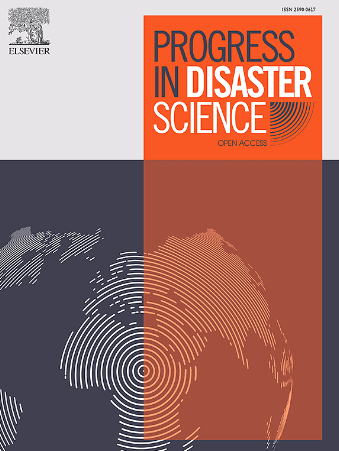弹性安置模式:人道主义发展关系的进展和新见解
IF 3.8
Q3 ENVIRONMENTAL SCIENCES
引用次数: 0
摘要
综合灾后恢复战略对于增强社会复原力和加快我们对《2015-2030年仙台减少灾害风险框架》的承诺至关重要。本研究提出了弹性安置模型(RRM),这是一个旨在在复杂灾害背景下共同实施弹性安置解决方案的新框架。本研究的目的是:i)从以往移民安置项目的经验观察中找出设计考虑因素,强调“更好地重建”、“更快地反弹”和“加强降低风险”的原则;Ii)为灾后情景下的弹性安置设计制定理论框架;iii)建立RRM以支持人道主义与发展联系(HDN)。本研究在系统文献综述、实地观察、调查、循证案例研究和专家验证的基础上,采用基于东南亚地区三次重大灾害的两阶段序贯混合方法设计方法。探讨了2004年印度尼西亚亚齐印度洋地震和海啸、2014年马来西亚吉兰丹洪水以及2018年印度尼西亚帕卢地震和海啸中MERCY参与的安置实施模式和最佳实践的新见解。这项研究强调了规划和设计因素在成功安置工作中的关键作用。本研究综合了二十年的国际人道主义经验,为灾后重建准备战略和建议提供了前瞻性的观点,这些战略和建议将物理、环境、社会、经济和制度因素纳入设计考虑,以实现有弹性的灾后重建。本文章由计算机程序翻译,如有差异,请以英文原文为准。
Resilient resettlement model: Progress and new insights into humanitarian-development Nexus
An integrated post-disaster recovery (PDR) strategy is pivotal to enhance societal resilience and accelerate our commitment to the Sendai Framework for Disaster Risk Reduction 2015–2030. This study presents the Resilient Resettlement Model (RRM), a novel framework designed to co-implement resilient resettlement solutions in complex disaster contexts. This study aims: i) to identify design considerations derived from empirical observations of past resettlement projects, emphasizing principles: ‘Build Back Better,’ ‘Bounce Back Faster,’ and ‘Strengthen Risk Reduction’; ii) to develop a theoretical framework for resilient resettlement design in post-disaster scenarios; and iii) to establish the RRM to support the Humanitarian-Development Nexus (HDN). Based on the systematic literature reviews, field observations, surveys, evidence-based case studies, and expert validation, this study adopts a two-phase sequential mixed-method design approach based on three significant disasters in the Southeast Asia region. The MERCY Malaysia's involvement in the 2004 Indian Ocean Earthquake and Tsunami in Aceh, Indonesia, the 2014 Kelantan flood in Malaysia, and the 2018 Palu Earthquake and Tsunami in Indonesia were explored to uncover new insights into resettlement implementation model and best practices. The study highlights the critical role of planning and design considerations in successful resettlement efforts. Integrating two decades of international humanitarian experience, this research offers prospective views to the disaster recovery preparedness strategies and recommendations that incorporate physical, environmental, social, economic, and institutional components of design considerations towards achieving resilient post-disaster resettlements.
求助全文
通过发布文献求助,成功后即可免费获取论文全文。
去求助
来源期刊

Progress in Disaster Science
Social Sciences-Safety Research
CiteScore
14.60
自引率
3.20%
发文量
51
审稿时长
12 weeks
期刊介绍:
Progress in Disaster Science is a Gold Open Access journal focusing on integrating research and policy in disaster research, and publishes original research papers and invited viewpoint articles on disaster risk reduction; response; emergency management and recovery.
A key part of the Journal's Publication output will see key experts invited to assess and comment on the current trends in disaster research, as well as highlight key papers.
 求助内容:
求助内容: 应助结果提醒方式:
应助结果提醒方式:


